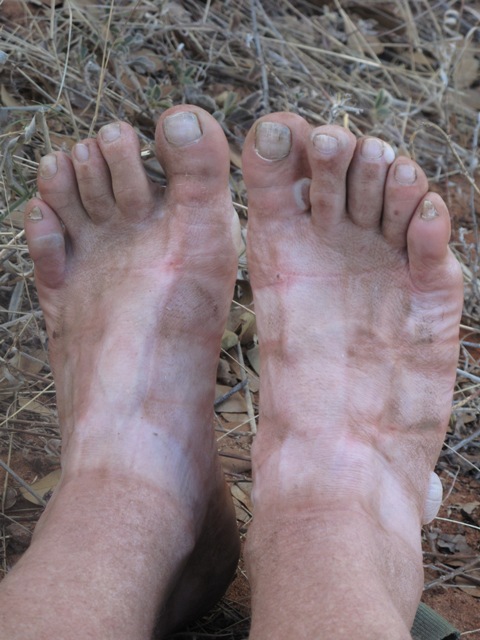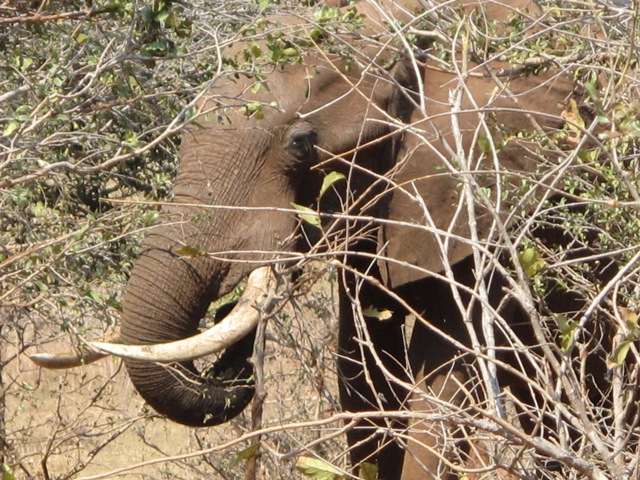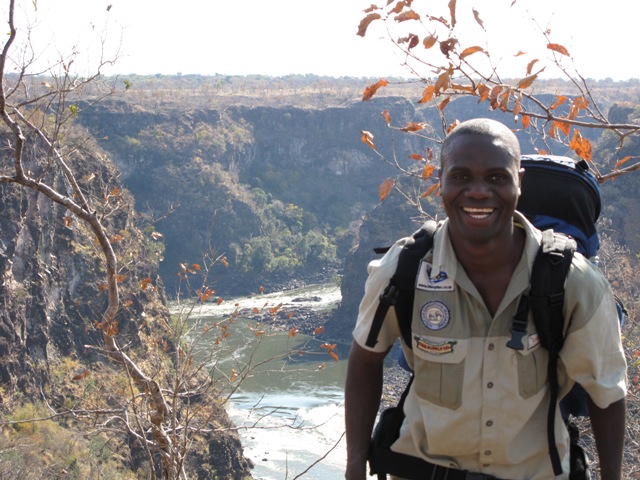As it happened, our departure from Victoria Falls was somewhat uninspiring, given that we left from the goods train station and followed the railway line out of town. This route came about not through choice, but the lack of it. A few days prior we had embarked on a reconnaissance patrol from the bridge just below the Falls, sticking to the river as closely as possible. Five or so kilometers and several mighty gorges later we began to realize what we were in for and a change of strategy came about – we would set off from the train station and move inland until we reached less hostile terrain, and then cut a trail parallel to the river and a couple of kilometers from it. Theory is always simple but our theory did not account for the erratic path of the Zambezi River below the Falls. It was not long before we found ourselves completely flummoxed by gorges, zigzagging our way down to the river and being forced to pull out each time we reached it. Impassable frustration is what those gorges amount to.

After a few hours of blundering about exceedingly rugged country, we came to a game fence. Game fence? That was quite surprising because we were under the impression that we would be walking directly into Hwange communal land from Victoria Falls. Anyway, there was nothing to do but follow the game fence away from the river. Garmin indicated that the fence would take us to the main Victoria Falls road and this increased the frustration markedly – the last thing we wanted was to set off on the Borderline Walk along the main road. Fortunately, as it turned out, we encountered a gamescout patrol walking down the fence and struck up a conversation. I told them what we were about and produced our permit from the National Parks Director General. This led to the scouts contacting their boss, Mr Roger Parry, who arrived shortly afterwards. Roger was most helpful and understanding and we soon had permission to walk through what turned out to be a wilderness area co-managed by National Parks and Wild Horizons, whom Roger works for.
The first significant action of the Borderline Walk took place whilst we were working our way down the Masuwe River back towards the Zambezi, within the wilderness area. We were walking through a patch of Mopani and I had just told Jephita to keep his eyes open for elephants, when he hissed out some word I didn’t catch but immediately recognized as a warning. Attempting to sidestep danger I had not yet seen, I tripped over a stump and went down heavily. From ground level, I saw an old buffalo bull crashing off through the scrub away from us. Funny now but not then – if the dagga boy had happened to be an angry elephant cow the Borderline Walk could have come to an inglorious end right then and there!
The second significant action of the expedition took place an hour or so later, whilst we were relaxing in the shade eating lunch somewhere on the Masuwe. Somehow and unbeknown to me, a bug crawled up my leg and into the danger zone. After a time, we got to our feet, hoisted backpacks and were on our way, me transporting an unwanted passenger. I still don’t know if that bug bit me or exuded some kind of poison, but less than fifty yards from our lunch spot I was hopping about and hollering in pain. I got the bug out of my pants and all I remember is that it looked much like a ladybug but was entirely grey. That was pain personified and it took time to fade.
The third significant action was tackling gorge eleven and it was action indeed. Fortunately, we encountered some more wilderness area scouts just before we reached that terrifying obstacle and they guided us to a ‘path’ and helped us down, up and across. I still do not know how I crossed that gorge, though Jephita performed commendably. I simply slid down and gasped my way up the other side, most of the way simply resigning myself to the fact that a fall and broken neck were inevitable. Once we made it through gorge eleven, I could go no further and we set up camp and settled down for the night. It was 4 p.m. and we were a mere ten kilometers from the Falls. I felt as if we had done a hundred. Feasting on kapenta and sadza and then bedding down on the hard earth that night was quite a revelation for me, having been treated like a king at Russell Caldecott’s Ultimate Guest Lodge the previous couple of weeks. To tell the truth, at that stage I was too tired to care.
Just after dawn the following morning, we were greeted by the sound of revving trucks and loud voices. As it turned out, our camp site was the gorge eleven launching pad for various whitewater rafting companies and they were preparing for a large number of clients who would arrive later. We got chatting to the rafters and they advised us on the way forward, bearing in mind that we already had gorge phobia. The rafters directed us in a southerly direction up a track that led into some low-lying hills. They said that after a few kilometers we would come to a game fence (the eastern boundary of the wilderness area), and that we should follow that fence in a north-easterly direction back towards the river and a village named Chisuma. We thanked them for the advice but didn’t take all of it, Jephita fast pointing out that it defied logic to walk south and then north. Not long after leaving the rafters, we left the track and moved east. Pocketing the GPS, I instructed Jephita to hold a straight line, which he did impeccably. A couple of hours later we reached the game fence, crossed beneath it and struck out through the bush for Chisuma Village, reaching that place in the late afternoon. Although we made a very late start that morning, we still managed twenty kilometers on day two. That evening we camped in the most spectacular spot, overlooking a massive gorge that falls away hundreds of meters to the Zambezi River below. Whilst we were setting up camp on level ground overlooking this stunning scenery, some young children arrived and began fooling about on the very lip of the gorge! I couldn’t believe it and reprimanded them. They giggled and continued their horseplay – jumping from rock to rock on the edge of the abyss. Their actions caused me genuine fear though they assured me that they played there regularly and that there was no danger! I did manage to get them away from the edge for about half an hour, when I offered biscuits in return for fetching water and firewood, but as soon as the chores were completed they went back to cavorting about half a meter from certain death. I have been having bad dreams about those kids.
The next morning we made an early start and it was most fortunate that we did, because by midday my feet had erupted in blisters. I guess it was inevitable – one can’t really expect to go from lethargic sloth to twenty five kilometers carrying twenty five kilograms overnight, now can one? We actually clocked twenty eight kilometers that day, and at least half that distance was absolute agony for me. By the time we reached the Kasikili police base well after dark, I was hobbling, shuffling and moaning and Jephita was patiently coaxing me on. When I had earlier explained to him that I had blisters, he wanted to know what blisters were!
On the fourth day we rested up at the Kasikili police base and were well looked after by Sergeant Kachana Gejo and his men, as well as the Kasikli locals. A couple of local youths brought us milk and a few vegetables and refused payment, although we did manage to square them up by buying a couple of chickens and some maize meal from them. Although my blisters were far from healed, I decided I was in good enough shape to make it to Batoka Gorge the following day. The plan was to make our way to Batoka and then cut a trail as close to the river as possible from there. Bad idea as we were to discover – the terrain below Batoka is just as intimidating as that below the Falls. We had no option but to retrace our steps from Batoka until we reached more manageable country, about seven or eight kilometers from the river. We camped in the bush somewhere on the fifth night, and were up and away early the following morning, walking north-east and intending to cut the border road at some point close to the Matetsi/Zambezi River junction. Our route actually brought us to the road about twenty kilometers shy of the Matetsi, at a village called Lombora. Here we were hosted by first-rate people – the Siziba Family – who shared their fire with us and allowed us to pitch our tent in their yard. As a matter of fact, since we left the Falls we have been treated in fine fashion by all the people we have encountered.

The people in this area are Matabele and that says it all. I thought language would be a problem as Jephita speaks only Shona and I speak only English and Shona, but this has not been the case – a healthy percentage of the people here in northern Matabeleland speak Shona, specifically the children who learn it at school.
We made an early start on day seven from Lombora and arrived at the Matetsi River in the late afternoon. We found a great campsite about a kilometer below the bridge and a couple of kilometers from the Zambezi River. We managed to have a good scrub in the Matetsi and it felt fine to go to bed clean – our last effective wash had been at Kasikili police base. The next day we walked down to the Zambezi River through the hills and were at Deka Drum by Midday. Deka Drum is so named because at one time a mystery drummer perplexed the community by beating his drums throughout the night. Nobody ever discovered the identity of the drummer, but he no longer beats his drums. Maybe he has moved on, to another area or another world.
Truth told, Deka Drum is looking tired, and this was made even more apparent the following day when we arrived at the Msuna Fishing camp about twenty kilometers downstream from Deka. It is like chalk and cheese – whilst Deka is looking tired, Msuna is fresh, like an oasis. I was actually irritated by the advice we received at Deka – we were told that the Deka River could not be crossed by any means other than the bridge, and yet when we got to the bridge we saw that the river was not a very intimidating obstacle at all.

I am certain we could have crossed far downstream and thereby saved ourselves many kilometers of foot-slogging, but that’s the way it goes, I suppose. In any case, we arrived at Msuna late in the afternoon of day eleven and asked permission to pitch our tent. Lo and behold, we were offered a free chalet and all kinds of help and advice. Our clothes were washed, we managed to fully charge our camera, sat phone, etc and we were given free fish and vegetables etc, etc. I certainly didn’t mind being back in the lap of luxury! How fine it felt to sleep on a mattress once more! At Msuna we were hosted by the chairman, Larry Cumming, and his wife Judy, Ken and Gay Smith and Dean and Sonja Todd – splendid people and gracious hosts who are blessed to stay in such a spectacular place.
Right now, it is the morning of day thirteen and we are just about to head out from Msuna, our next destinations being Devil’s Gorge, the Gwaii River and Mlibizi. From there it is Binga, the Kariba shoreline and Kariba town itself. Once we reach Kariba town, we will be able to say that we have completed a stage. I guess we will be in Kariba in three weeks to a month from now. Although we have been going for thirteen days already, it should be remembered that three of those days were rest (recovery) days and on the day we walked down to Batoka Gorge from Kasikili, no progress was made. Therefore, we have been progressing along the borderline for only nine days. Divided by one hundred and forty kilometers (as the crow flies) and it amounts to an average of fifteen kilometers a day. But the truth is that we have done much more than one hundred and forty kilometers – endless zigzagging to begin with and the side-trip to Batoka. In reality, I believe we are averaging twenty kilometers on walking days.
We are in good health and spirits ad the blisters are all healed. We have concerns – armed Zambian cattle rustlers and lions are up ahead – but we are confident that we will continue to have a trouble free journey by keeping a very low profile and not looking for trouble. I am fairly reluctant to leave this fantastic place but the Borderline Walk must go on! Thank you one and all for your support and I will be sure to write another update as soon as possible. I apologize for this hurried report but that’s what it is – hurried. There is internet here at Msuna and I am not sure when I will next be able to get online – possibly only at Kariba.

